|
Native Plant of the Month
|
Horsemint
Monarda punctata
Moisture: Dry
Exposure: Full or Partial Sun
Bloom: July-September
Color: White/Lavender
Height: 0.5-3 ft.
A clump-forming plant with hairy square stems and leaves. It is an aromatic plant that smells like oregano. The dull yellow flowers spotted with purple are tubular and arranged in small compact heads subtended by a whorl of pink to purple-tinged showy leafy bracts. The bract-supported flower heads are arranged in several tiers on the flower stalk. This species has greater tolerance of drought than the other Monarda species. Found in dry soils of prairies, sandy areas, and coastal plains. Flowers visited for nectar and pollen by bees and nectar by hummingbirds. Plants used for medicine by Native Americans. Other common names are dotted horsemint, spotted horsemint, and spotted bee balm.
|
|
Invasive Plant of the Month
|
Leafy Spurge
Euphorbia esula
Exposure: Partial Shade/ Full Sun
Moisture: Moist/Dry
Height: 1-2 feet
Blooms: May-September
Description: A biennial from Asia, this weed spreads by rhizomes and seed that can stay viable for years. Leafy spurge is a prohibited noxious weed on Minnesota Department of Agriculture's Control List, meaning all propagating parts must be destroyed. It has an umbrella shaped cluster of yellowish-green flowers and narrow, pointed leaves along the stem. It also has a milky sap that can irritate skin. Leafy Spurge forms dense colonies that degrade native habitat and can degrade fields as well as be harmful to livestock. Management strategies include select herbicide treatments, hand-pulling, and mowing. Small infestations should be removed before they become a larger and harder to control.
|
|
Pollinator of the Month
|
Monarch Butterfly
Danaus plexippus

Range: Southern Canada and entire United States
Habitat: Prairies, gardens, open fields
Adult Identification: Tops of wings have a distinctive orange coloring with black veins and white spots around the tips of the wings. The underside of their wings are a lighter orange and their bodies are all black except for more white dots on their faces and underside.
Caterpillar Identification: Caterpillars
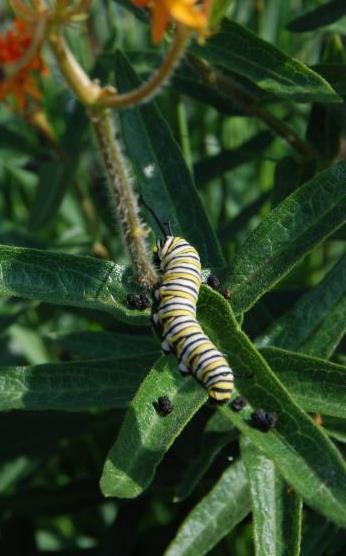
have black, yellow, and white stripes all down their bodies with a pair of tentacles at their head and shorter tentacles in the back.
Pollination: Adults feed on nectar from many native species including Milkweed species, Coneflower species, Liatris species, Joe-Pye weed, Aster species, and many more.
Every fall Monarchs in northern climates migrate south, either to Mexico or areas in California, trips that can be up to 2,500 miles! Unfortunately, over the last few years their populations have declined significantly due to habitat destruction along their migration paths. The larval stage of this butterfly completely relies on members of the Milkweed family for survival. Visit our Facebook page here to learn more about the Monarch's decline and remember to plant Milkweed in your garden this spring!
|
|
Garden Club Tours!
|
Natural Shore Technologies is now hosting FREE field trips for Garden Clubs with 10 or more members. Come join our Native Plant Specialist Shirley Mah Kooyman for a 1 hour lecture and tour of our retail nursery in Maple Plain! Your club will get an up close experience learning more about Minnesota Natives!
Choose from one of the following lectures:
- Minnesota's Native Plants: A Sampling for Your Garden
- Landscaping with Native Plants
- Top 30 Native Plants for your Garden
|
|
Retail Nursery
|
Our Retail Nursery will reopen next May! Visit our website at
Naturalshore.com for Plant lists, prices, and store updates.
|
|
|
December Article
|
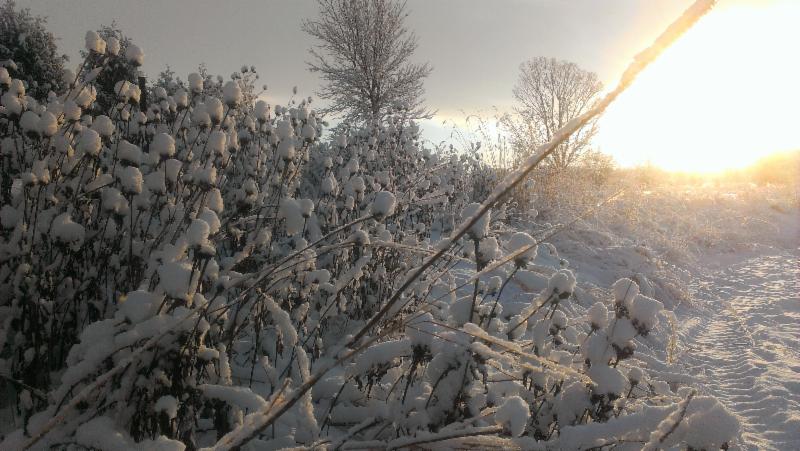
Winter Wildlife Habitat
It's December in Minnesota and winter is definitely starting to settle in.
Snow, ice, wind... the whole shebang. Now is the time most of us are doing our yearly lawn work before those bigger snowstorms hit. Raking leaves, cutting down, and cleaning out old vegetation in our gardens. But maybe we do something different this year and leave all that standing vegetation up for the Minnesota wildlife to take advantage of over the long, cold months ahead. What animals dare to stay in Minnesota instead of migrating towards warmer climates? Deer, rabbits, fox, raccoons, mice, and a variety of other mammals do not migrate or hibernate in the winter. Some common songbirds you might see as well are Cardinals, Chickadees, Blue Jays, Pheasants, Woodpeckers, Grosbeaks, Finches, Redpolls, Nuthatches, and many more.
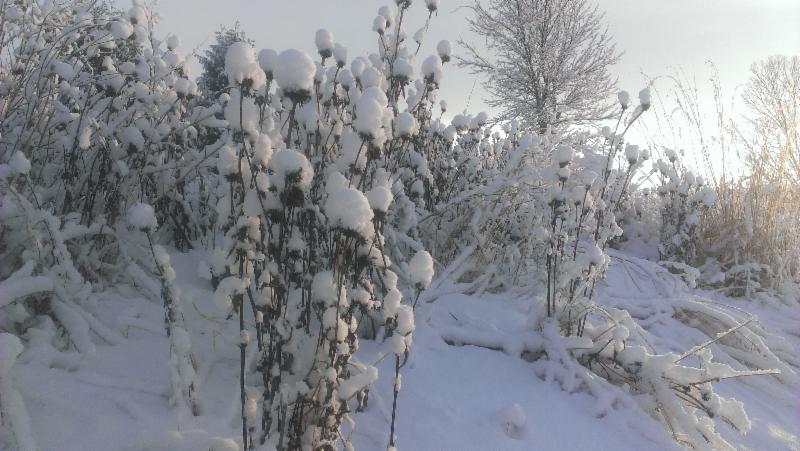 We all know how cold winter here in Minnesota can get, but imagine what its like for all our native wildlife who are exposed to the elements and in a constant search for food. Many native flowers and grasses provide such a food source, here are a few examples: We all know how cold winter here in Minnesota can get, but imagine what its like for all our native wildlife who are exposed to the elements and in a constant search for food. Many native flowers and grasses provide such a food source, here are a few examples:
1. Purple or Pale Purple Coneflowers provide an excellent seed source for many over-wintering songbirds.
2. Bergamot seeds are eaten by a variety of birds including Goldfinches.
3. Rattlesnake Master holds onto its seeds long into the winter, providing food for birds later than other seed sources.
4. Prairie Onion bulbs, like the bulbs of cultivated onions are edible and eaten by many small mammals like squirrels and chipmunks.
5. Blue and Hoary Vervain are also eaten by birds like Cardinals over the winter, which then help spread the seed!
6. Prairie Dropseed and Indian Grass are two attractive grasses that add aesthetic beauty to a garden during the winter but also have seeds high in nutrients for birds and small mammals.
 Native plants not only provide food, but shelter as well from predators, harsh winds, and cold temperatures. Birds might be able to raid their local bird feeders during the winter, but without shelter, they will struggle to survive our brutal winters. What great native plants provide shelter for birds and other wildlife? Native plants not only provide food, but shelter as well from predators, harsh winds, and cold temperatures. Birds might be able to raid their local bird feeders during the winter, but without shelter, they will struggle to survive our brutal winters. What great native plants provide shelter for birds and other wildlife?
1. Grasses and sedges like Little Bluestem, Big Bluestem, Prairie Cordgrass, Lake Sedge, and Fox Sedge provide dense cover and structure for burrowing into the snow.
2. Shrubs like Red Osier Dogwood, Bush
Honeysuckle, and Highbush Cranberry provide intricate
branches for songbirds to fly into
to avoid predators and form groups to keep warm. (They also love the berries!)
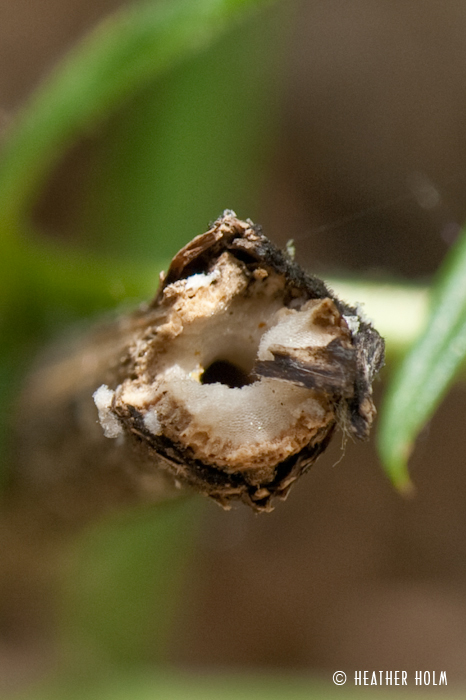 |
|
Photo by Heather Holm
|
3. Many tall native flowers like
Anise Hyssop, New
England Aster, Boneset, Oxeye, and Virginia Mountain
Mint form dense clusters or fall over in the fall which provide shelter for many small mammals and birds.
4. Tall flowers with hollow stems like Joe Pye Weed or Cup Plant are
great for native bees who make a nest in the stem cavity.
S
o help out our wildlife this winter
by keeping the vegetation in your native landscape up through the season! Sit back with a cup of hot cocoa and have fun observing the visitors in your yard!
|
 |
|
Company News
|
|
Friendship Village Pond gets a Facelift!
NST crews were out the pond this fall to remove Buckthorn around their duck pond. This is phase one in restoring native habitat around the pond in order to attract more wildlife.
Taking Down Retail Nursery for the Year
Our retail nursery in Maple Plain Minnesota has been put to bed for the season and we are already looking forward to selling more plants this spring! Thank you to everyone who visited us this year for supporting us as your local source for native plants!
Over-seeding Native Restorations 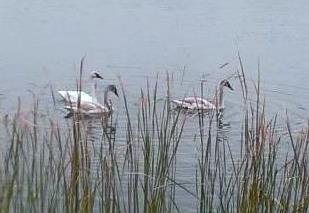
We have visited some of our restorations this fall throwing down seed that will be stratified by the winter's freeze and thaw actions. This allows the seeds to germinate in the spring! Here is a picture of some swans observing the over-seeding process in action at Birch Lake in White Bear Lake!
|
|